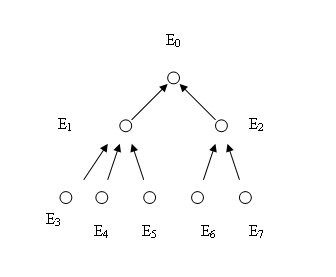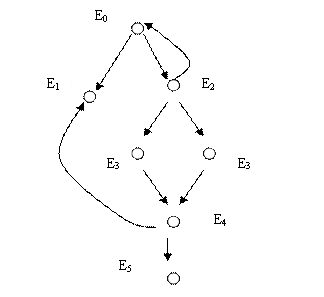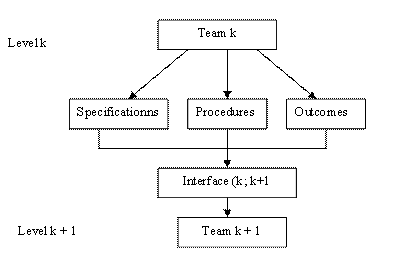 |
|
|||
Interdisciplinarity - A Requirement of The Modern and Efficient Research
Keywords
interdisciplinarity, modern research, efficient research
Table of Contents
The Interdisciplinary Research
The team research structures and interfaces for communication
The common communication language
The building a simulation model
Conclusions
References
Abstract
Interdisciplinarity is considered the best way for research. This paper presents the interdisciplinary concept, and defines the necessary and sufficient conditions for developing an efficient interdisciplinary research. There are underlined the needed elements to build correct, concise, and consistent interfaces that assure the continuity, in order to develop a common research language. It is, also, developed an interdisciplinary model, based on a collaborative structure.
The Interdisciplinary Research
Let us consider the disjunctive research domains D1, D2, Dn. Each domain has its own vocabulary, respectively, V1, V2, Vn.
 for any I<>J; I, J in {1, 2, n}.
for any I<>J; I, J in {1, 2, n}.
Each domain, Di, is characterized by:
- primary axioms and notions;
- theories and models for describing and explaining phenomena, processes, correlations, evolutions and structures;
- outcomes obtained in the course of time, in order to emphasize new characteristics, new interactions, new processes, new effects, and new procedures.
The level of generality concerning the approaching methods has increased in the course of time, reaching a saturation level. Having in view this aspect, the activities for discovering new materials, new processes, new equipments, new methods, and new models within the respectively domain, is becoming more and more difficult, or, may be, impossible. For solving this problem it is necessary build an interdisciplinary team made up of specialists within the domain Di, and specialists from others domains. This is the best, and, may be, the only way to develop the necessary premises in order to obtain a significant qualitative leap regarding to the new discoveries.
Nowadays, a solitary researcher, having encyclopedic knowledge is not a realistic approach. In the modern research, the interdisciplinarity is imposed by the following challenges:
- the enhancement of the each research domain complexity;
- biologically limits concerning the assimilation of knowledge from various areas by a single person;
- a problem solution is obtained using knowledge from one domain, experimentally results obtained using tools from other domain, and the applicability is for a target group belonging to the other one;
- the necessary time to solve a problem, for example in the health care domain, requires the simultaneously development of the research process stages; such kind of approaching is possible only whether exist high qualified specialists who simultaneously approach the process stages;
- the existence of a common language, imposed by the research project management, leads both to an evident delimitation of the research stages, and to the increasing of the specialization level; in others words this leads to the increasing of the labor division;
- the necessity to maintain the costs under control
- assisting the research processes, that imposes a collaborative style, within the messages exchanges are developing by direct and efficient flows, flows that are quantifiable by their generated effects.
The interdisciplinarity assumes a new researcher type that has an activity based on procedures, within a team, where his role is well defined.
The team research structures and interfaces for communication
There are researches where the activities are sequentially developed, figure 1.

Figure 1 The sequential research structure
Each specialist type has a unique intervention within a well defined time framework. For the specified inputs and for expected outcomes, the specialists apply methods, techniques, algorithms, use tools, assembly objects, and the results from the Ei stage are used by an other specialist team to develop the Ei+1 research stage.
At the En stage end the estimated outcomes of the interdisciplinary research are obtained.
The tree structure assumes a detailed research stages, figure 2, in such way that each researcher has precise tasks, and the outcomes are assembled step by step, in order to accomplish the goal, figure 3.

Figure 2 The three research structure
The tree structure associated to the research process assumes the simultaneous development of the E1 and E2, E3, E4, and E5, and E6 and E7 stages.

Figure 3 The research outcomes assembly
The graph structure is the most common structure regarding an interdisciplinary research process organization, or regarding interdisciplinary executable projects development, figure 4.

Figure 4 The graph structure
The graph structure gives the possibility to make analyses, and if the obtained outcomes differ from the planned ones, the process is resumed form the certain stage. If the expected outcomes are obtained in advance from the planned stage, some stages are eliminated.
The common communication language
The interdisciplinarity assumes that to each structure node is associated a team consisting of high qualified specialists, and the obtained outcomes are taken by an other team having different qualifications.
A node with the complex structure is defined for each level. At the informational level, the specifications offered by the team from previous level K are given together with procedures and the outcomes, figure 5.

Figure 5 The communication interface among the teams belonging to the Dk, respectively Dk+1, domains
The interdisciplinarity assumes the existence of a common vocabulary Vcom, so that to each word ci Vcom, corresponds a word or a text belonging to the Vi vocabulary, i = 1, 2, n, associated to the domain Di. In other words, the interface have to be built using texts made of the words belonging to the Vcom vocabulary, and the teams have all the necessary resources in order to develop activities according to their activity domains specificity.
The translation from a text built by the Di domain team, using Vi vocabulary, to a text built by the Dj domain team, using the Vj vocabulary, is possible only using a language based on Vcom vocabulary, figure 6.

Figure 6 The translation from the specialists within Di, Dj domains
The building a simulation model
The simulation is, by excellence, an interdisciplinary mode. For the domain DP, taken into consideration, it is necessary a team consisting of specialists who know:
- the inputs of the real system;
- the processing stages;
- the mechanisms of the transformation which took place within each stage;
- the manufacturing receipts;
- the processes management.
The simulation module assumes data gathering, which is realized by:
- using the measurement and recording devices, and building data time series that are stored in database, giving a clear image concerning the processes that take place within a time period, enough long;
- planning the experiments in order to see the system comportment, using methods with variable levels of completeness, having in view to keep under control both costs, and risks levels.
The data gathering needs specialists who know very well measurement and control devices, and, also, know the basic elements regarding data quality management, DQ.
In order to assure the reproducibility, at a certain scale, of the processes for which the simulation model is built, it is necessary a team made up of statisticians, DT. Applying some specific test, this team verifies if the data recording frequencies, that reflect the dynamic of the factors which are interacting within the system, are in accordance with certain repartition laws.
The results given by the teams belonging to DP, DQ, and DT domains, are using by the simulation domain team, DS, which builds the simulation model through:
- choosing the significant variables:
- establishing the restrictions;
- defining the objective function;
- defining the variation domains;
- building the selection criteria.
The simulation model is taken by the specialists who use the simulation languages, or develop the specialized software, DA, and the model implementation takes place.
Using data set inputs, which are obtained on the work assumptions base, the specialist in the simulation systems comportment studying obtain the results that are used in decision making that are applied to the real system in order to:
- optimize the real system comportment;
- optimize the real system structure in accordance with given optimum criteria.
Such kind of approaching in impossible without interdisciplinary. If the optimization refers to processes that take places within complex chemical installations, or it refers the manufacturing a high speed vehicle, or the optimization refers to the manufacturing receipt, only the collaborative messages exchange among specialists belonging to the domains that contribute to reach the planned goal.
Conclusions
The interdisciplinarity is both a reality and a condition in order to successfully develop projects. The interdisciplinary approach requires to define:
- the project size;
- the project goal;
- the typology of the messages which are sent to the target group;
- the schedule.
The domains such are aeronautics, virusology, ecology, construction industry, food processing, agriculture are developing only by interdisciplinary approach concerning both the research activities, and practical activities.
The interdisciplinarity assumes to train both the researchers and the practitioners in order to learn a simple and efficient communication language, to learn to appreciate the work of the specialists belonging to other domains, and to respect them and their work results.
References
1. Basarab Nicolescu: The Transdisciplinary Evolution of the University
Condition for Sustainable Development, Bulletin Interactif du Centre International
de Recherches et Etudes transdisciplinaires no 12 - Fevrier 1998,
2. Ion Ivan, Marius
Popa, Gheorghe Nosca: Knowledge-Based
Research Network Oriented To Small And Medium Enterprises; Design And
Implementation Guidelines, Proceedings of The 30th Annual Congress of
3. Helga Nowotny: Interdisciplinarity research - Why does it matter? NEST CONFERENCE 2005, 20-21 September 2005, www.helga-nowotny.at
4. Julie Thompson Klein: Interdisciplinarity and complexity: An evolving relationship, 2 E: CO Vol. 6 Nos. 1-2, 2004 pp. 2-10
(top)

